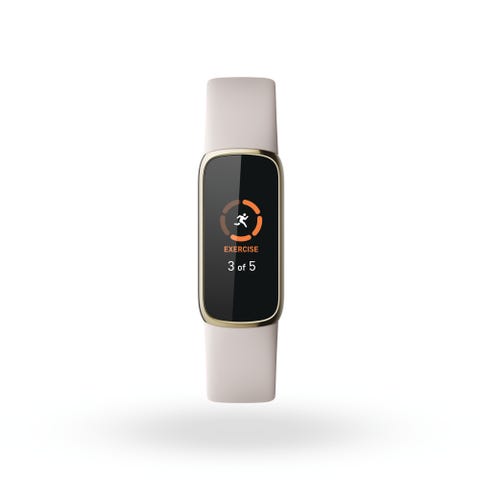The first wearable I ever reviewed, Fitbit’s Alta HR, was also the first time I tried out a device that tried to balance fitness appeal with fashion aesthetics. Back in 2017, this was a tough balancing act, but I liked the slim tracker and its ambitious (for the time) touch screen design.
Fast forward to 2021 and the company’s latest release, the aspirationally-named Luxe tracker. The new device looks to accomplish the same goal as the old one—bridging the gap between fitness tech and fashion—and in most ways, Fitbit has succeeded. The Luxe is as good as you’re going to get with a basic fitness tracker, and with a bevy of eye-catching accessories that won’t look out of place paired with formalwear, you won’t feel the need to take it off when you get dressed up outside the gym.

The Luxe is so much smaller and lighter than the trackers and smartwatches I’ve grown accustomed to wearing that the testing period felt like I was giving my wrist a breather. The tracker itself builds on the shape of the brand’s most basic device, the Inspire 2, with better materials. The Luxe has a stainless steel casing with subtly rounded corners and features a sleek-looking touchscreen interface that stays a reflective inky black until you wake it up for use. The metal casing and screen catch the light like a piece of jewelry, rather than sitting on the wrist as a blank chunk of plastic when not “awake”, a major plus. The total lack of buttons—even the novel inductive control spots Fitbit uses in its Charge and Sense devices—was a good choice to keep the design seamless. That makes 24/7 wear for sleep tracking much more palatable, a major concern that many users have with bigger, bulkier devices.
Fitbit wisely opted for a comfortable silicone clasp band as its default attachment, although there are several other varieties available to class up the tracker, from a stainless steel mesh option I tried for a few days as a change of pace to leather and link bracelet accessories. These will cost you, but if you’re looking to live up to the Luxe name, you shouldn’t be terribly surprised that you’ll need to fork over more than the basic purchase price.

Using the Luxe is easy. The full-color touchscreen is bright and responsive, and getting the hang of the series of swipes and taps required to navigate the interface only took me a few tries. Thinking back to the times I struggled to swipe and jab through the Alta HR’s now-primitive touchscreen makes me laugh now as I slide my finger across the screen to start a 2 minute Relax breathing session without a single wasted movement.
I tracked a few workouts and runs wearing the Luxe. There are no surprises here if you’ve ever used a Fitbit device, and the barrier for entry is low if you never have. The slim design makes the Luxe much more functional than larger wearables for strength training— especially for workouts featuring exercises with wrist flexion like pushups and presses—but the tracking is fairly basic, even with over 20 exercise modes available.

Serious runners will miss the built-in GPS found in more spec-heavy devices (you’ll need your phone close by for GPS tracking with the Luxe), but those types of athletes would likely be happier with a more traditional wearable anyway. The fashion-first crowd the Luxe was designed for is much more likely to want a device to track their steps, heart rate, and Active Zone minutes—Fitbit’s more involved measure that debuted with the Charge 4 that takes its devices beyond the status of a glorified pedometer—than to obsess over high level performance data. That’s not to say the Luxe is a slouch in the data department, and Fitbit is offering six months of its Premium service free with every purchase, so wearers will have access to personalized insights, coaching, and workouts to keep them engaged.
The feature I was most impressed with was the Luxe’s battery. That sounds like a simple thing, but there are few qualities more important for a 24/7 wearable device. Fitbit advertises five days of power off a single charge. I used the Luxe for a full week before I needed to plug it back in for more juice. Over that time, I tracked several workouts and tested other features like the Relax sessions and using the timers and alarms. Performance might vary over time, but that’s a great power baseline to start—especially if you’re thinking of the Luxe as a statement piece meant to be a constant complement to your outfits.
Paying $150 for a basic fitness tracker might be a stretch, especially when the excellent Charge 4 with its built-in GPS and other premium workout features is right there at the same price point. The key for Fitbit, then, is emphasizing the Luxe’s aesthetics as much as its functionality. I liked having that touch of flair on my wrist while I was testing, and I think a significant number of people who care about their appearance just as much as their health will agree. Making a device that melded fashion and fitness really effectively might have taken Fitbit until 2021, but the Luxe is a testament to the concept that you can have both.
Source: Read Full Article